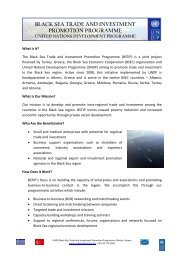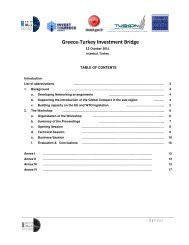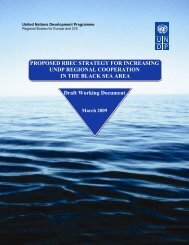Tradeflow Study - UNDP Black Sea Trade and Investment Promotion ...
Tradeflow Study - UNDP Black Sea Trade and Investment Promotion ...
Tradeflow Study - UNDP Black Sea Trade and Investment Promotion ...
You also want an ePaper? Increase the reach of your titles
YUMPU automatically turns print PDFs into web optimized ePapers that Google loves.
I. BSEC Economic Performance <strong>and</strong> <strong>Trade</strong> Cooperation<br />
I.1. <strong>Trade</strong> <strong>and</strong> <strong>Investment</strong> Context<br />
The BSEC represents a huge market of some 350 million people with a foreign trade capacity<br />
of over US$ 300 billion annually, an area of nearly 20 million square kilometres <strong>and</strong> rich in<br />
natural resources, <strong>and</strong> one of the European Union’s major energy supplier. Owing to its<br />
geographical location, the markets in the region could quite easily be integrated to the<br />
important markets of Europe, Central Asia <strong>and</strong>/or the Middle East. The BSEC region is a<br />
sizeable market by any criteria, <strong>and</strong> as such, is an attractive destination for both trade <strong>and</strong><br />
investment in several obvious areas such as transportation, communications, energy <strong>and</strong><br />
tourism.<br />
The most populous country in BSEC is the Russian Federation with 143 million inhabitants,<br />
followed by Turkey (73 million) <strong>and</strong> Ukraine (47 million). The populations of the BSEC<br />
countries add up to 350 million, which is around three quarters of the size of the population of<br />
the European Union (460 million) but significantly larger than the USA (297 million).<br />
In terms of l<strong>and</strong> area, the Russian Federation accounts for the largest surface area (17.1<br />
million square kilometres), followed by Turkey (0.8 million square kilometres) <strong>and</strong> Ukraine (0.6<br />
million square kilometres). However most of the surface area in Russia is not arable, in<br />
comparison to Turkey <strong>and</strong> Ukraine which have higher relative shares of arable l<strong>and</strong>.<br />
The size of the BSEC market is significant, at around US$ 1.6 trillion in 2005. However, there<br />
are major disparities in the size of economies across the region. Three countries, Greece, the<br />
Russian Federation <strong>and</strong> Turkey, alone constitute 83 % of BSEC’s GDP. On the other h<strong>and</strong>,<br />
five countries contribute less than 1% of BSEC’s GDP (Albania, Armenia, Azerbaijan, Georgia<br />
<strong>and</strong> Moldova). The estimated growth rate in 2006 for the region is high, with the highest<br />
annual growth rate of GDP originating in Azerbaijan (25 %). Armenia is estimated to have<br />
recorded 8.5% growth in 2006, followed by Georgia with 7.5%. The lowest economic growth<br />
has been recorded for Moldova (3.5%) 3 . Figure 1 highlights some of the basic<br />
macroeconomic indicators of the region <strong>and</strong> illustrates the great diversity of economies in the<br />
region, both in terms of GDP <strong>and</strong> in current account performance.<br />
3 EBRD Statistics<br />
13/135






